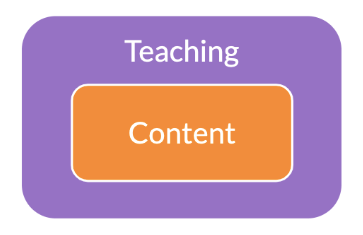There is a reason why teachers want to teach. There’s something special about helping someone feel empowered; assisting them to move from not understanding how to do something, to being capable of doing that thing themselves. Teaching is about guidance and growth through interaction, and in many ways benefits the teacher as well as the learner. None of this is revelatory, it is just the nature of this core type of human interaction.
With the rise of our digitally enmeshed world there has of course been an effort to shift the experience of learning online. In the desire to make educational experiences more widely available, and to augment in class instruction with rich examples and further resources, learning is something that increasingly happens at least in part (if not entirely) in a digital space.
But there is something broken here. In the vast majority of cases, this effort of ‘putting learning experiences online’ actually takes the form of making raw content available for individuals to browse in some form of learning management system. What results are text readings (quite often the regular materials tied to in class work) along with links to videos and other resources. While this goes in some way to giving students some things they can use to learn, the fact is that this is merely making content digital, and in the same way that ‘information is not knowledge’, content is not teaching. Content is required for education, it is the fundamental thing that learners need to understand, but for content to truly be meaningful and navigable it needs to be surrounded by a layer of teaching.

Teaching is really the user interface for raw content. When faced with a wall of content it is hard to see the focal points, it’s difficult to understand what is important and identify what the core trends and themes are. Through teaching there is the capacity to string content into a coherent and well paced narrative with an opportunity for meaningful interaction. Teaching provides the means to create new knowledge and awareness effectively. Granted, with effort, you can learn from content, but the act of purely giving someone content is not teaching.
Up until now there has been little opportunity to create such a meaningful teaching interface around raw content online because current digital learning tools do not allow for this. Existing systems do not have the necessary framing and interactive capacity to actually provide the space for teaching. Despite the efforts of individual educators to use LMS based systems for actual teaching, such forays really end up being ill fitting as these systems are designed primarily for content storage.
However, the new wave of online learning is here and with the new tools that are now available we have the capacity to take the actual act of teaching and put it online. For Smart Sparrow, this act of teaching online is enabled through aero, a courseware development platform that allows instructors to give responsive feedback and define learner pathways to provide interactive teaching and differentiated experiences. By responding to what students are doing and remembering what they have difficulty with, we have the capacity and the opportunity to design real learning moments as part of online experiences.
Moving towards this new medium, it feels like there would need to be fundamental changes, that we would need to learn how to ‘teach digitally’ as an entirely different skill. While there are inevitably new things to learn (such as some UX and branching logic skills for example), in fact, the most important thing for this new wave is actually a return to the core elements of teaching. The biggest risk is not making use of the capabilities of this new technology and continuing in the ‘content as online learning’ mould. Continuing on in such a content focused way, we really don’t get the opportunity to make use of the fruits of this new medium. With an eye on recreating a traditional 1-on-1 teaching interaction, we have the ability to make far more rich and meaningful online learning experiences.

For the remainder of this post I’d like to talk about two core elements of teaching that we need to make sure we retain in the transition to online teaching - teaching structure and teaching personality.
Teaching structure
If you were going to ‘teach’ something by preparing some static content (say a pdf) what would it look like? You would likely introduce the core ideas and then work progressively through the different concepts using text and diagrams in the most coherent flow. At various points you may refer to other media elements like videos (via links) which help to illustrate particular ideas well.
Something like this converts quite easily into an ‘online learning experience’. You could even add some questions at the end to test their understanding. But this is nowhere near making use of the capacity of the tools available for teaching - this is still largely a content transmission experience.
Instead, how would you teach a topic if you were sitting down with someone 1-on-1?
First, you would probably ask them if they knew anything about the topic and perhaps ask them one or two questions to gauge their understanding of the key ideas. Then you might ask them to try and complete an example while you watch and advise on what they are doing (as a further diagnostic). You would likely ask them questions to see if they have any particular misconceptions or specifically give them an example where they are going to encounter one of the key misconceptions they could have, and thus have the opportunity to correct it. You would perhaps guide them through the process of actually performing the objective task giving them feedback at key junctures as they work their way through it.
My point is that we can create the above teaching experiences in the new digital teaching environment. Through diagnostic questions and activities we can define which students are in need of different explanations, or more examples, and take them to these materials. Via a range of flexible inputs, it is possible to create interactions and simulative type experiences where students are given immediate feedback as they attempt to actually perform the task (rather than just hearing about the steps or being told what it is like to perform it).
So the take-home here is, before you try to ‘make an online lesson’, think about how you would teach a student 1-on-1 and what that experience would be like. Rather than thinking of a linear journey through the context and content, consider how would you most efficiently get to that student’s knowledge gap and help bridge it.
Teaching personality
There is nothing better than a David Attenborough nature documentary. Turning on the TV when your not quite sure what to watch, it’s hard to flick past David explaining the courting habits of the velvet worm. But on the other hand, if you happen to turn to a nature documentary and its not David, well, it feels a little bit off. This is because David’s personality has become so tied to this form of learning interaction that it is critical to the form itself. The courting habits of the velvet worm are interesting because David is fascinated by it, and his interest frames the materials.
My point here is that personality is a critical part of teaching, and it is often lost through the focus towards ‘content transmission’ in the digital realm where there is little space for it. The role of the teacher isn’t purely ‘functional’, that is, making sure that relevant feedback is given and that the content is apportioned correctly according to level of understanding. It is also aesthetic (for want of a better term), by framing and adding flavour to the content through personality.

This also isn’t a revelatory concept, we all know that a good teacher can make you interested in something that would otherwise be uninteresting due to their passion for the topic and the way they teach it. However, with the shift to the online space this seems to be one of the first things to go. In this new space the technology and admin elements get in the way and push things towards a generic voiceless form.
So how do we make sure we retain elements of personality in our online teaching experiences? The first step is simply remembering that personality is important and considering this as you frame your lesson. With this in mind one is far more likely to do the usual things you would do as part of a teaching experience, things like:
- allaying learner anxieties about the content
- providing highlighted encouragement for particularly difficult concepts
- communicating in meaningful ways why this knowledge/skill will be useful to them and why this content is interesting
- telling anecdotes that may not be included as content, but really do help learners grapple with a concept and inspire students to further explore on their own.
Personality can also be implemented through the feedback. In this way there really is a chance to have a dialogue with learners and reinforce that this is a person that they are interacting with (asynchronously, but still a person).
So consider the difference between getting feedback which says:
“Please attempt the question”
Or instead being met with:
“Hey where do you think you’re going? You need to give it a try!”
This personality and dialogue brings the materials and the experience to life. This isn’t content that is uncomfortable interacting with you because it is not designed to do so, it is teaching which expects you as a learner to act in specific ways and is able to respond to these behaviours.
So our take away? - Before making your online teaching experience take the time to consider the tone and language you would use as a teacher to teach these materials and what dialogue would you frame the content with. Take a moment to write down any off-the-cuff anecdotes you can remember so that you have the chance to include them when you get to that concept.
Conclusion
The new wave of digital teaching is here, and while we do need to look forward, we also need to be looking back to make sure that we do not lose those key elements that make teaching special, for the sake of them learners experiencing it but also for the teachers making the experiences.


